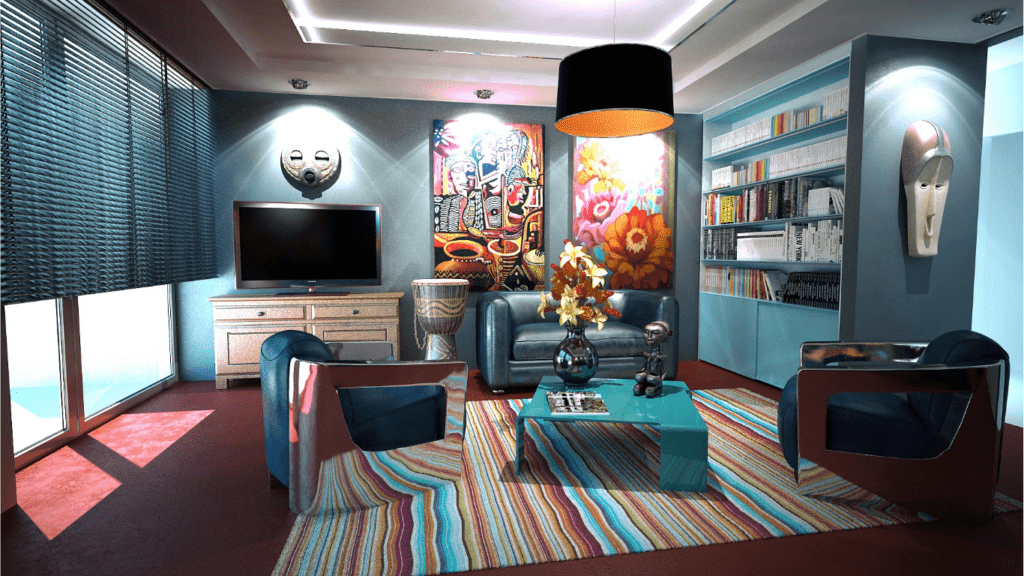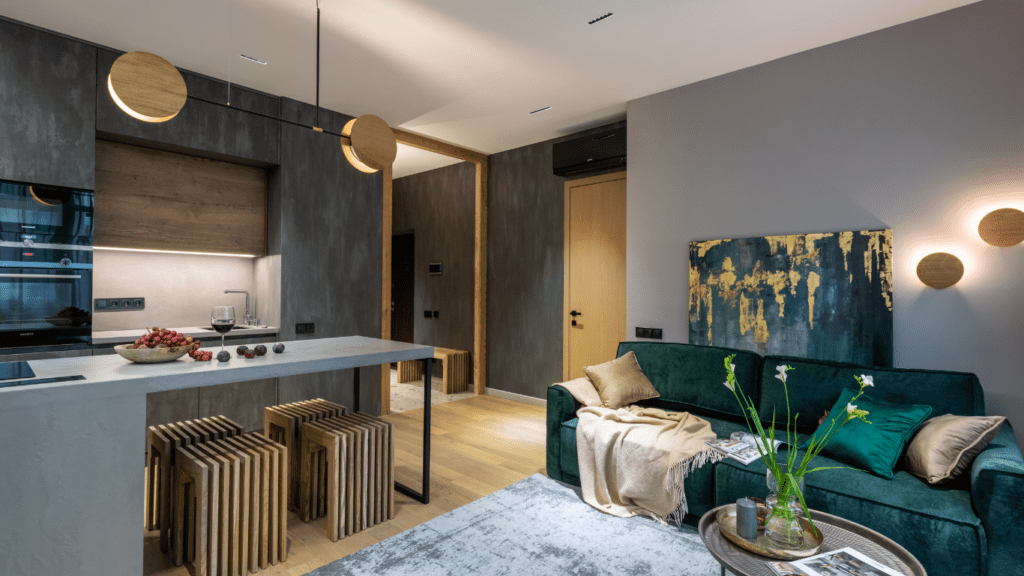What Is Biophilic Design?
Biophilic design incorporates natural elements into built environments. It aims to create spaces that promote well-being by connecting inhabitants with nature. This design philosophy isn’t new, yet its application in modern interiors has gained substantial traction. Architects and interior designers use biophilic principles to include elements like natural light, plants, and water features. These inclusions aim to create a more holistic living experience.
Key aspects of biophilic design involve the integration of six primary elements:
- Natural Light: Large windows and skylights help maximize exposure to sunlight.
- Air Quality: Ventilation systems and plant arrangements improve indoor air quality.
- Natural Materials: Wood, stone, and bamboo add organic textures.
- Water Features: Fountains and aquariums introduce the calming sounds of water.
- Greenery: Indoor plants and green walls enhance air quality and aesthetics.
- Views of Nature: Strategic window placements provide visual connections to outdoor landscapes.
Biophilic design also extends beyond visual elements. It incorporates sensory experiences. For example, the scent of flowers or the sound of a small water fountain enhances the overall ambiance. Research supports that such environments reduce stress, improve cognitive function, and enhance mood. According to a study by Terrapin Bright Green, incorporating nature into design can result in a 15% increase in well-being and productivity.
Professionals across various fields recognize the benefits of biophilic design. From corporate offices to residential properties, the intentional inclusion of nature brings positive changes. Thus, biophilic design isn’t just an aesthetic choice; it’s a well-rounded approach to creating healthier, happier spaces.
Key Principles Of Biophilic Design
Biophilic design relies on key principles to create nature-inspired interiors that promote well-being. These principles guide the integration of natural elements, maximizing natural light, and using organic shapes.
Incorporating Natural Elements
Incorporating natural elements involves adding materials and features from nature. This can include wood, stone, and plants. Green walls with climbing plants and indoor gardens provide greenery. Water features like fountains or aquariums introduce the calming effect of water. These elements create a direct connection to nature within interiors.
Maximizing Natural Light
Maximizing natural light enhances spaces by using sunlight. This principle involves large windows, skylights, and glass doors. Reflective surfaces and light-colored interiors help distribute sunlight. Using adjustable shades maintains the balance of light and privacy. Design strategies focus on ensuring occupants receive ample natural light, improving mood and productivity.
Using Organic Shapes And Forms
Using organic shapes and forms mimics nature’s geometry. This approach integrates curves, undulating lines, and asymmetry instead of rigid, linear forms. Furniture with flowing lines and architecture with rounded edges embody this principle. Natural patterns, such as leaf motifs and wave designs, enhance the biophilic environment. These shapes create a sense of movement and harmony within spaces.
Benefits Of Biophilic Design

Biophilic design offers numerous advantages, making it a game-changer in interior design. This section delves into the various benefits that nature-inspired interiors provide.
Mental Health Improvements
Incorporating natural elements into interiors significantly enhances mental health. Exposure to natural light reduces stress and anxiety, backed by a study from the Journal of Environmental Psychology showing a 16% increase in well-being. Natural materials like wood and stone create a calming effect, aiding in relaxation. Seeing greenery or water features lowers blood pressure, promoting tranquility. Sensory experiences, such as the scent of flowers or the sound of water, foster a serene atmosphere.
Enhanced Productivity
Biophilic environments boost productivity levels. An analysis by the American Psychological Association highlights a 15% increase in productivity for individuals working in nature-inspired spaces. Natural light and improved air quality lead to better concentration. Workspaces integrating greenery and organic shapes reduce mental fatigue. Employees feel more creative, evidenced by 6% higher reported innovation rates in biophilic offices according to the World Green Building Council.
Physical Health Benefits
Biophilic design also benefits physical health. Enhanced air quality from plant integration reduces respiratory issues, supported by NASA’s Clean Air Study data. Natural lighting helps regulate circadian rhythms, improving sleep patterns. The presence of natural elements like wood has been linked to lower heart rates and reduced stress levels. Physical contact with natural materials can improve overall well-being, making biophilic interiors holistic health enhancers.
Popular Biophilic Design Trends
Biophilic design trends are reshaping interiors with nature-inspired elements that boost well-being.
Indoor Greenery And Living Walls
Incorporating indoor greenery into spaces connects inhabitants with nature. Plants like snake plants, fiddle leaf figs, and succulents enhance air quality and aesthetic appeal. Living walls, also known as green walls, are vertical gardens that transform blank walls into lush landscapes. These installations use a combination of plants to create visually striking features that also absorb sound and offer privacy.
Water Features
Water features add a calming presence to interiors. These include fountains, indoor ponds, and aquariums, which introduce the soothing sound of water. Research by the University of Exeter reveals that water features can significantly reduce stress levels. Including water elements in design not only promotes relaxation but also maintains humidity levels, which benefits respiratory health.
Natural Materials And Textures
Using natural materials brings an organic feel to interiors. Incorporating materials like wood, stone, and bamboo connects occupants with nature’s textures. Furniture crafted from reclaimed wood provides a rustic charm, while stone countertops add durability and elegance. Additionally, textiles such as cotton, wool, and linen contribute to a tactile experience, enhancing comfort and aesthetic appeal.
Challenges And Considerations
Biophilic design offers numerous benefits but comes with its own set of challenges and considerations. I’ve identified the most pertinent issues to help navigate these complexities.
Maintenance And Upkeep
Maintaining natural elements can be labor-intensive. Regular care is crucial, as plants need consistent watering, pruning, and sometimes pest control. If neglected, they can deteriorate, impacting the overall aesthetic. For example, living walls demand specialized maintenance due to their complexity. Water features require periodic cleaning to prevent algae buildup, ensuring they remain functional and visually appealing. Maintaining these elements involves more than routine cleaning—it often necessitates a deeper understanding of the biological needs of plants and water systems.
Budget Constraints
Biophilic design can initially seem expensive. Costs can quickly add up when accounting for high-quality natural materials, specialized lighting, and maintenance systems. For example, incorporating large windows or skylights to maximize natural light may require structural changes, increasing the budget significantly. Additionally, sourcing sustainable materials like FSC-certified wood or natural stone can elevate costs. It’s vital to plan meticulously to balance design aspirations with financial realities.
Real-Life Examples Of Biophilic Design
Biophilic design has made a significant impact across both residential and commercial settings. Let’s explore some real-life applications that showcase how nature-inspired interiors enhance everyday environments.
Residential Spaces
In urban apartments, green walls and indoor gardens bring life to confined areas. Luxurious homes often feature expansive glass windows that provide uninterrupted views of landscaped gardens, blending indoor and outdoor living spaces. In addition, many bedrooms adopt natural materials like wood and organic cotton to create a soothing retreat.
- Green Walls: Apartments in New York often use vertical gardens to maximize greenery.
- Large Windows: Homes in California boast floor-to-ceiling windows overlooking scenic views.
- Natural Materials: Bedrooms in Scandinavian designs frequently incorporate oak flooring and linen fabrics.
Commercial Spaces
Numerous workplaces leverage biophilic design to boost employee well-being and productivity. Tech companies use living walls and vast atriums filled with natural light to create stimulating work environments. Retail spaces introduce water features and abundant indoor plants to improve customer experience and encourage longer visits.
- Living Walls: Offices in Silicon Valley employ green walls in communal areas.
- Natural Light: Headquarters in Seattle use glass atriums to flood interiors with daylight.
- Water Features: Shops in major malls incorporate indoor fountains and ponds to elevate the shopping ambiance.



 Betsylie Sheetsin – Home Renovation Expert
Betsylie Sheetsin serves as the Home Renovation Expert at Castle Shelf House, specializing in giving practical advice for both small and large-scale home improvements. With years of experience in construction and renovation, Betsylie understands the importance of blending durability with design. Her insights into home renovation projects, along with expert advice on the latest materials and techniques, empower homeowners to tackle even the most ambitious projects confidently.
Betsylie Sheetsin – Home Renovation Expert
Betsylie Sheetsin serves as the Home Renovation Expert at Castle Shelf House, specializing in giving practical advice for both small and large-scale home improvements. With years of experience in construction and renovation, Betsylie understands the importance of blending durability with design. Her insights into home renovation projects, along with expert advice on the latest materials and techniques, empower homeowners to tackle even the most ambitious projects confidently.
